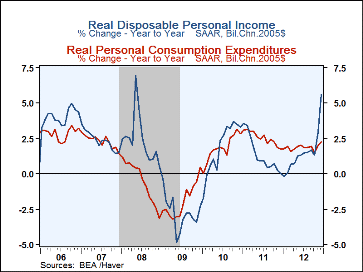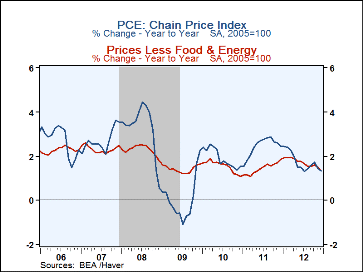 Global| Jan 31 2013
Global| Jan 31 2013U.S. Income Surges But Spending Slows
by:Tom Moeller
|in:Economy in Brief
Summary
Personal income jumped 2.6% (6.9% y/y) last month after a revised 1.0% November gain, initially reported as 0.6%. A 0.8% rise was the consensus expectation. Last month's jump centered on a 34.3% surge (49.6% y/y) in dividend income. [...]
 Personal income jumped 2.6% (6.9% y/y) last month after a
revised 1.0% November gain, initially reported as 0.6%. A 0.8% rise was
the consensus expectation. Last month's jump centered on a 34.3% surge
(49.6% y/y) in dividend income. For all of 2012, total personal income
growth decelerated to 3.5% from 5.1% in 2011. Income other than from
dividends was solid last month. Wage & salary earnings rose a firm
0.6% (4.6% y/y) following an upwardly revised 0.9% November jump. Interest
income surged 1.9% (2.7% y/y) and proprietors' income rose 0.8% (5.8% y/y.
To the moderate side, transfer receipts increased 0.4% (3.5% y/y) while
rental incomes rose 0.4% (12.5% y/y) as well.
Personal income jumped 2.6% (6.9% y/y) last month after a
revised 1.0% November gain, initially reported as 0.6%. A 0.8% rise was
the consensus expectation. Last month's jump centered on a 34.3% surge
(49.6% y/y) in dividend income. For all of 2012, total personal income
growth decelerated to 3.5% from 5.1% in 2011. Income other than from
dividends was solid last month. Wage & salary earnings rose a firm
0.6% (4.6% y/y) following an upwardly revised 0.9% November jump. Interest
income surged 1.9% (2.7% y/y) and proprietors' income rose 0.8% (5.8% y/y.
To the moderate side, transfer receipts increased 0.4% (3.5% y/y) while
rental incomes rose 0.4% (12.5% y/y) as well.
Despite the surge in income, consumers raised spending by just 0.2% (3.6% y/y). That followed an unrevised 0.4% November rise and compared to expectations for a 0.3% gain. Leading last month's spending was a 2.2% rise (11.8% y/y) in motor vehicle purchases and a 0.9% gain (4.4% y/y) in home furnishings & appliances. Services spending increased a modest 0.2% (3.2% y/y) but purchases of nondurables fell 0.2% (+2.7% y/y). That decline was led by lessened outlays for gasoline, off 4.0% (+0.9% y/y) due to lower prices. Spending on clothing rose 0.7% (4.2% y/y).
With the jump in income and the modest gain in spending, the personal savings rate surged to 6.5%, its highest level since May of 2009. That's up from 3.9% for all of 2012.
The PCE chain price index dipped slightly (+1.3% y/y) with a 2.1% decline (+1.8% y/y) in gasoline prices, the third consecutive monthly fall. Prices excluding food and energy also were unchanged (1.4% y/y) for the second consecutive month. Motor vehicle costs were unchanged (0.6% y/y); furniture prices fell 0.3% (-0.5% y/y) and clothing prices dropped 0.2% (+1.9% y/y). Services prices ticked up 0.1% (1.9% y/y).
Adjusted for price changes, disposable income gained 2.8% (2.5% y/y) and real spending rose 0.2% (2.2% y/y) during December.
The personal income & consumption figures are available in Haver's USECON and USNA databases. The consensus expectations figures are in the AS1REPNA database.
| Personal Income & Outlays (%) | Dec | Nov | Oct | Y/Y | 2012 | 2011 | 2010 |
|---|---|---|---|---|---|---|---|
| Personal Income | 2.6 | 1.0 | 0.1 | 6.9 | 3.5 | 5.1 | 3.8 |
| Wages & Salaries | 0.6 | 0.9 | -0.2 | 4.6 | 3.2 | 4.0 | 2.1 |
| Disposable Personal Income | 2.7 | 1.0 | 0.1 | 7.0 | 3.3 | 3.8 | 3.8 |
| Personal Consumption Expenditures | 0.2 | 0.4 | -0.1 | 3.6 | 3.6 | 5.0 | 3.8 |
| Personal Saving Rate | 6.5 | 4.1 | 3.4 | 3.4 (Dec'11) |
3.9 | 14.2 | 5.1 |
| PCE Chain Price Index | -0.0 | -0.2 | 0.1 | 1.3 | 1.7 | 2.4 | 1.9 |
| Less Food & Energy | 0.0 | 0.0 | 0.1 | 1.4 | 1.7 | 1.4 | 1.5 |
| Real Disposable Income | 2.8 | 1.3 | -0.1 | 5.6 | 1.5 | 1.3 | 1.8 |
| Real Personal Consumption Expenditures |
0.2 | 0.6 | -0.2 | 2.2 | 1.9 | 2.5 | 1.8 |
Tom Moeller
AuthorMore in Author Profile »Prior to joining Haver Analytics in 2000, Mr. Moeller worked as the Economist at Chancellor Capital Management from 1985 to 1999. There, he developed comprehensive economic forecasts and interpreted economic data for equity and fixed income portfolio managers. Also at Chancellor, Mr. Moeller worked as an equity analyst and was responsible for researching and rating companies in the economically sensitive automobile and housing industries for investment in Chancellor’s equity portfolio. Prior to joining Chancellor, Mr. Moeller was an Economist at Citibank from 1979 to 1984. He also analyzed pricing behavior in the metals industry for the Council on Wage and Price Stability in Washington, D.C. In 1999, Mr. Moeller received the award for most accurate forecast from the Forecasters' Club of New York. From 1990 to 1992 he was President of the New York Association for Business Economists. Mr. Moeller earned an M.B.A. in Finance from Fordham University, where he graduated in 1987. He holds a Bachelor of Arts in Economics from George Washington University.








